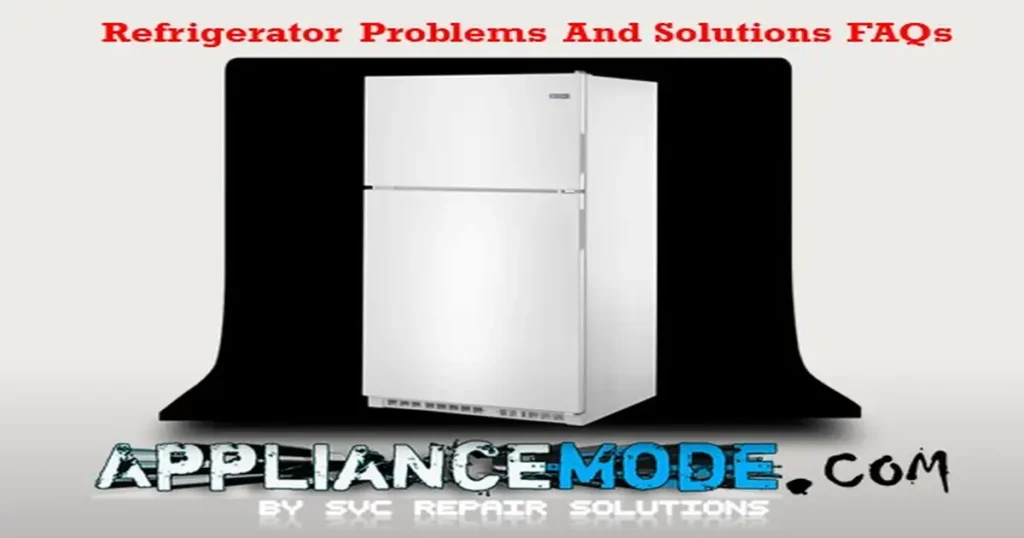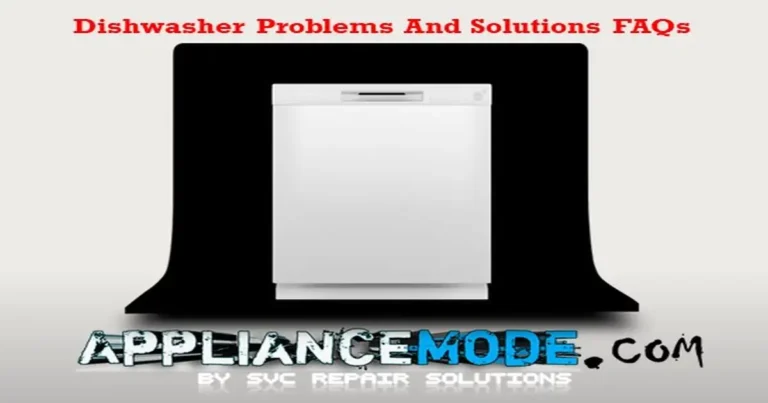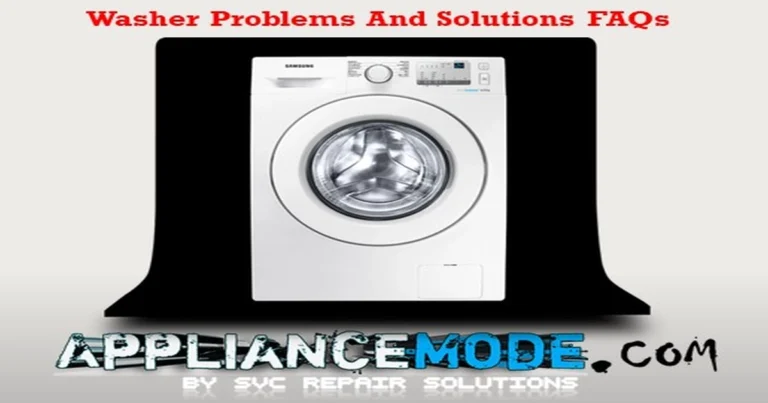On this page
ToggleWelcome to our refrigerator FAQ post! If you’re experiencing troubles with your LG, Samsung, KitchenAid, Whirlpool, or any other brand of refrigerator, you’ve come to the right place. In this post, we’ll provide you with solutions to help you better understand and potentially solve most of the issues that can arise with your refrigerator.

One thing to keep in mind is that while your refrigerator may display an error code, it doesn’t necessarily mean that the component indicated is faulty. It’s important to first check the connections of the wiring and rule out any connection issues before proceeding with replacing the component. This is just one example of the kind of troubleshooting tips we’ll be sharing in this post, “Refrigerator Problems and Solutions FAQ.”. So, if you’re ready to learn how to keep your fridge running smoothly, keep reading!
Refrigerator problems and solutions FAQs: Diagnostic and Troubleshooting Guide Q&A
If the display won’t light up, this could be caused by several issues, including the refrigerator not being switched on, an unplugged power cord, a wall outlet without power, or melted internal safety fuses. Here are the steps to solve the problem:
- Switch on the refrigerator.
- Do not use an extension block! Plug the power cord directly into a wall outlet.
- Check and activate the main power fuse.
- Unplug the refrigerator. Use another working appliance to check the wall outlet, or plug the refrigerator into another working outlet.
- Measure for 110/220 VAC at the wall outlet. Check the power assembly and the internal safety fuse.
- Check the display PCB buttons.
- Check the harness on the main PCB.
If you’re observing water inside or around the refrigerator, this could be caused by several issues, including melted water due to an unwanted defrost, a clogged drain pipe, an overflowing drip tray, a bad connection at the bottom of the door(s), a bad connection at the water tap, a bad connection to the external filter, a bad connection at the water inlet valve, a not completely closed ice dispenser valve, too high external water pressure, or abnormal water supply to the ice maker. Here are the steps to solve the problem:
- Check if the refrigerator is turned on, the compressor is running, and the cooling and freezing temperatures are normal. If this is not the case, the cooling process is disturbed.
- Check inside the refrigerator to see if the drain is clogged (water at the bottom).
- Check at the dispenser if the water is dripping just after dispensing or continuously. After dispensing is normal, continuous dripping could increase the pressure on the water line and reduce the water supply, if necessary, by turning the water tap. Power off the refrigerator and check the water inlet valve to see if water is still supplied.
- Check the water hoses at the doors for proper connection. Warning: Pulling the hoses without removing the retainer will damage the hose.
- Check the water hose connecting the tap, the external filter, and the water inlet valve at the back. Check the water level of the drip tray. Note: This tray collects the water from the defrost cycle that normally evaporates due to the heat of the condenser.
- Check the ice dispenser valve.
- Check the filling of the ice-maker tray.
- Check the refrigerant level. A heavy repair could be necessary.
This can be caused by various reasons, such as a recently installed new plumbing connection, a problem with the harness, a recently replaced ice maker or water dispenser, ice or water stored for a long period, a water filter used for too long, a dirty ice bin or dispenser, or strong-smelling food.
What steps can be taken to solve the problem of a strange taste or smell of water or ice in the refrigerator?
Some of the steps that can be taken include checking for any waterworks or plumbing activities that may have taken place, cleaning the ice bin and dispenser, checking the water filter and using only the recommended types by the manufacturer, removing any present ice cubes and making a new supply, and flushing at least 5 glasses of water.
A rotten smell in the refrigerator can be caused by various reasons, such as old food or leftovers stored in the refrigerator, food deteriorating due to an unwanted defrost, items outside the refrigerator, or clogged drain pipes.
What steps can be taken to solve the problem of a rotten smell in the refrigerator?
Some of the steps that can be taken include checking with the customer how long the water has been in the tank, emptying and cleaning the tank, checking the water filter, removing any old food or leftovers stored in the refrigerator, and checking for any clogged drain pipes or items outside the refrigerator.
A chemical odor, a sweet petrol-like smell, along with rising temperatures and decreased cooling capacity in the refrigerator could be caused by a leakage in the cooling system (sealed system).
What steps can be taken to solve the problem of chemical smells in the refrigerator?
Some of the steps that can be taken include checking if the refrigerator is turned on and the compressor is running, checking the cooling and freezing temperature, checking the refrigerant level, and carrying out heavy repair work if necessary.
Excessive food smells in the refrigerator can be caused by open packages in the refrigerator or freezer or by food deteriorating due to an unwanted defrost.
What steps can be taken to solve the problem of excessive food smells in the refrigerator?
Some of the steps that can be taken include checking for open packages with distinct-smelling food, using well-sealing containers to prevent air contamination, checking if the refrigerator is turned on and the compressor is running, checking the cooling and freezing temperatures, and checking the refrigerant level.
A burning smell in the refrigerator could be caused by new electronics, an overloaded motor, or overheated parts.
What steps can be taken to solve the problem of a burning smell in the refrigerator?
Some of the steps that can be taken include checking the friction of the motor parts, checking the power connections and assemblies, checking if the connectors on the assemblies are fully inserted, and checking for overheating in the compressor room.
If you observe that the display lights and temperature selection work but the refrigerator does not cool or freeze, this could be caused by the refrigerator being set to ‘DEMO MODE’, an interrupted cooling process, or a faulty main PCB. To solve the problem, you should check if the refrigerator is in ‘DEMO MODE’, if the compressor is running, if the cooling and freezing temperatures are normal, and if the cooling process is disturbed. You should also check the refrigerant level, display assembly, harness to the main PCB, and main PCB itself.
If you notice that the lamps in your refrigerator are not working when you open the door, this could be caused by an unplugged power cord or a burned or loose lamp. To solve the problem, you should unplug and reinsert the power cord and check it. If this does not work, you should unplug the refrigerator and check or replace the lamp according to the instructions in the manual. Note that in newer models with LED light strips, you cannot replace them, and a technician needs to replace the faulty light.
If you observe that the doors on your refrigerator are not closing on their own or are hard to close, this could be caused by an unevenly installed refrigerator, packages blocking the door, shelves or bins blocking the door, or doors being wrongly installed after removal.
To solve the problem, you should check the leveling of the refrigerator, turn the front feet down so that the refrigerator leans slightly backward, check if all door bins and shelves are well-inserted and packages do not create an obstruction, check if the doors and hinges are well-installed and aligned, and check if the refrigerator is square or rectangular and adjust accordingly.
If you notice that the doors on your refrigerator are difficult to open, this could be caused by dirty or sticky gaskets, the door being reopened within a very short time, an unevenly installed refrigerator, or doors being wrongly installed after removal.
To solve the problem, you should clean the door gaskets with a mild soap and water solution, check if the door opens easily after 5 minutes, check the leveling of the refrigerator, turn the front feet down so that the refrigerator leans slightly backward, check if the doors and hinges are well-installed and aligned, and check if the refrigerator is square or rectangular and adjust accordingly.
This can be caused by several factors, such as a closed water supply, a kinked tube, a faulty water dispenser, a faulty main PCB, or an empty water tank.
To solve the problem, you should check if the water tap is fully open and the water runs properly to the refrigerator through the tube (not kinked), check if the water tank is filled (non-plumbing only), and check the water pump (non-plumbing only).
This can be caused by various reasons, such as a newly installed refrigerator not yet on temperature, the temperature set to more than -18 degrees (warmer), a blocked air flow, a faulty water tank sensor, or a faulty main PCB.
To solve the problem, you should check if the newly installed refrigerator has stabilized for at least 24 hours, adjust the temperature settings, check the air flow to the water dispenser and water tank, and check the main PCB.
This can be caused by several factors, such as a newly installed refrigerator not yet on temperature, a switched-off ice maker, a closed water supply or kinked tube, blocked air flow, a faulty ice maker, a faulty main PCB, or an empty water tank (non-plumbing only).
To solve the problem, you should check if the water tap is fully open and the water runs properly to the refrigerator through the tube (not kinked), check if the ice maker is switched on, and check the air flow to the ice maker.
This can be caused by various reasons, such as a newly installed refrigerator not yet on temperature, a too-warm freezer, a closed water supply or kinked tube, an ice cube blocking the flow, too long storage time, reduced airflow, or an aged water filter.
To solve the problem, you should check if the water tap is fully open and the water runs properly to the refrigerator through the tube (not kinked), test the ice maker, and check if the newly installed refrigerator has been stabilized for at least 24 hours.
This can be caused by various factors, such as a recently installed new plumbing connection, a recently replaced ice maker, water tubes or water tank, or a dirty ice bin or ice dispenser.
To solve the problem, you should check for any waterworks or plumbing activities that have taken place, clean the ice bin and the ice dispenser, and check the water filter and replace it if necessary.
Moisture outside the refrigerator could be caused by a humid room, insufficient ventilation flow, a problem with the doors or gaskets, or insufficient isolation.
What steps can be taken to solve the problem of moisture outside the refrigerator?
To solve the problem of moisture outside the refrigerator, you can wipe the outside surface with a dry cloth to remove moisture, check the ventilation flow around the refrigerator to reduce the settling of moisture, check if the performance of the refrigerator is decreasing, check if the door closes and the gaskets seal properly, check the ice dispenser gasket or home-bar gasket, check the hot line, and check the inner lining and the fixation of the shelves.
Moisture inside the refrigerator could be caused by a humid room, the door opening too often, food not being stored properly, or a problem with the doors or gaskets.
What steps can be taken to solve the problem of moisture inside the refrigerator?
To solve the problem of moisture inside the refrigerator, you can check how often and long the customer opens the door, check that all food is properly stored in containers or wrapped tightly to reduce the humidity, check if the door closes and the gaskets seal properly, check the ice dispenser gasket or home-bar gasket, check the ventilation flow in the refrigerator, and ensure the evaporator is not clogged with ice.
Frost inside the freezer or around the refrigerator doors could be caused by a humid room, the door opening long or often, food not being stored properly, a problem with the doors or gaskets, an item blocking the door, or an open vent in the Magic Crisper box that contains humid food.
What steps can be taken to solve the problem of frost inside the freezer or around the refrigerator doors?
To solve the problem of frost inside the freezer or around the refrigerator doors, you can check how often and long the customer opens the door, check that all food is properly stored in containers or wrapped tightly to reduce the humidity, check if the door closes and the gaskets seal properly, check the ice dispenser gasket or home-bar gasket, check that the humidity selector for the Magic Crisper is closed, check the ventilation flow in the refrigerator, and ensure the evaporator is not clogged with ice.
Abnormal sounds in the refrigerator could be caused by pipes hitting the compressor, a fan with damaged blades, an obstructed airflow out of the refrigerator, or too much refrigerant in the refrigerator.
What steps can be taken to solve the problem of abnormal sounds in the refrigerator?
To solve the problem of abnormal sounds in the refrigerator, you can explain to the customer how a refrigerator works with the cold and warm parts in the system and what normal sounds can occur; check that the drain pipe valve at the back is not blocked; check the pipes connected to the compressor; check the compressor and the rubber suspension; check the fan blades for damages; check that the damping rubber covers the joint of the evaporator and the capillary tube; and check the accumulator for frost buildup.
If you observe vibrations during the operation of your refrigerator, either by touching the refrigerator or by hearing the sounds of resonating items, there are a few possible causes. It could be caused by reduced shock absorption of the compressor, insufficient space at one of the sides of the refrigerator, or the refrigerator not standing level and on an uneven floor. To solve this problem, you can check if the refrigerator is touching the wall, ensure that there is enough space for ventilation, check the leveling of the refrigerator, and check the shock absorption of the compressor.
If you observe that your refrigerator is too cold or that food is too cold or frozen, there are several possible causes. It could be due to the temperature being set to less than 4 degrees, food stored in front of an air duct, limited or blocked ventilation, a faulty thermistor, a faulty damper or baffle, or a faulty main PCB. To solve this problem, you can check the cooling temperature, ensure that the food is not in front of the air vents, make sure that cold air can flow correctly through the storage area, ensure that the refrigerator is installed correctly with enough room for ventilation, and check the main PCB.
If you observe that your freezer is too cold, with ice cream not being well-structured anymore, there are several possible causes. It could be due to the temperature being set to less than -18 degrees, food stored in front of an air duct, limited or blocked ventilation, a faulty thermistor, a faulty damper or baffle, or a faulty main PCB.
To solve this problem, you can check the freezing temperature, ensure that the food is not in front of the air vents, make sure that cold air can flow correctly through the storage area, ensure that the freezer is installed correctly with enough room for ventilation, and check the main PCB.
If you notice that your refrigerator is too warm, there are several possible causes. It could be due to a newly installed refrigerator not yet on temperature, the temperature set to more than 4 degrees, the door being opened long or often, the door not closing properly, a large number of items added to the storage room, a blocked airflow, limited or blocked ventilation, an insufficient cooling process, an insufficient isolation of the door, a faulty thermistor, a faulty damper or baffle, or a faulty main PCB.
To solve this problem, you can check if the refrigerator is turned on and the cooling and freezing temperatures are normal; check if the newly installed refrigerator has been stabilized for at least 24 hours; ensure that the cold air can flow correctly through the storage area; and check the main PCB.
There are several possible causes, including a newly installed refrigerator not yet at temperature, the temperature being set to above -18 degrees Celsius (warmer), the door being opened for long periods or frequently, the door not closing properly, a large amount of items added to the storage room, a blocked airflow, limited or blocked ventilation, insufficient cooling, insufficient door insulation, a low surrounding temperature, a faulty thermistor, a faulty damper or baffle, or a faulty main PCB.
- Check if the refrigerator is turned on and if the compressor is running at normal cooling and freezing temperatures.
- If not, the cooling process may be disturbed.
- Make sure the newly installed refrigerator has stabilized for at least 24 hours.
- Check if the freezing temperature is set to -18 degrees Celsius.
- Ensure that the cold air can flow correctly through the storage area and that food is not blocking the air vents.
- Check how often and for how long the customer opens the door and if the door closes and the gaskets seal properly.
- Check for recent additions of a large amount of food and ensure the refrigerator is installed correctly with enough room for ventilation.
- Set the control to a colder setting for compensation, check the thermistor value and ventilation flow in the machine room, clean the condenser if needed, and check the main PCB and refrigerant level if necessary.
A blinking LED on the main PCB of a refrigerator may be caused by a faulty harness, compressor, clogged cycle system, high ambient temperature, or faulty main PCB.
What steps can be taken to solve the problem of a blinking main PCB LED on a refrigerator?
First, unplug the refrigerator and wait for 60 seconds before restarting it. Then, check how many times the LED on the main PCB blinks, which can indicate the severity of the problem. The meaning of each LED blinking will be explained in a separate article.

I am a master Appliance Repair technician with over 35 years of experience in the field. I am passionate about helping people troubleshoot their appliances and fix common problems. My website, appliancemode.com, provides a wealth of information on troubleshooting common appliance issues and deciphering error codes. This website aims to empower people to tackle appliance repairs themselves and save money on service calls.



